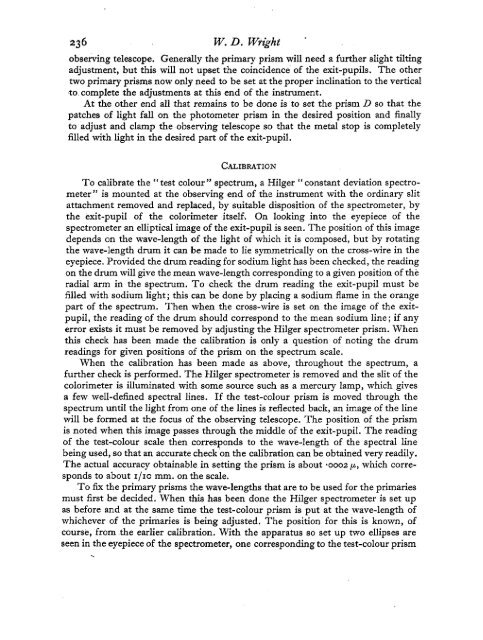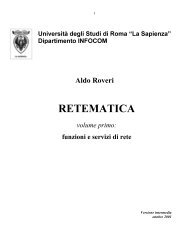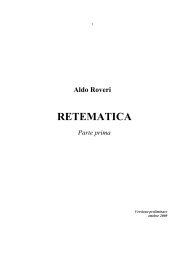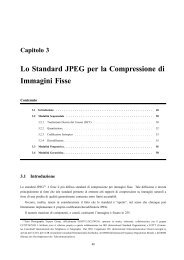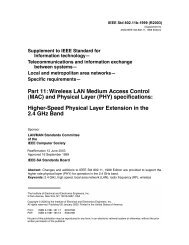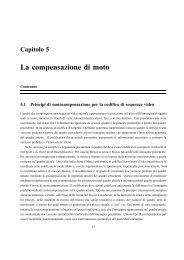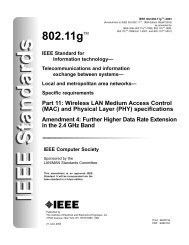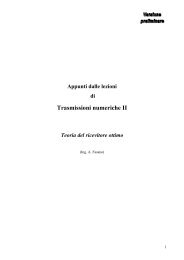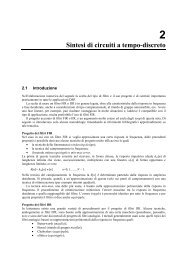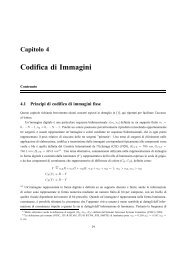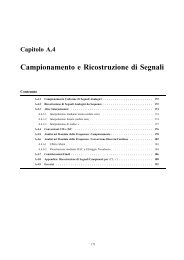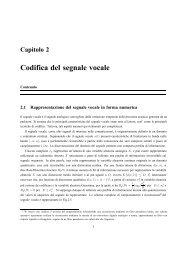a trichromatic colorimeter with spectral primaries - InfoCom
a trichromatic colorimeter with spectral primaries - InfoCom
a trichromatic colorimeter with spectral primaries - InfoCom
Create successful ePaper yourself
Turn your PDF publications into a flip-book with our unique Google optimized e-Paper software.
236 W.D. W7kht -<br />
observing telescope. Generally the primary prism will need a further slight tilting<br />
adjustment, but this will not upset the coincidence of the exit-pupils. The other<br />
two primary prisms now only need to be set at the proper inclination to the vertical<br />
to complete the adjustments at this end of the instrument.<br />
At the other end all that remains to be done is to set the prism D so that the<br />
patches of light fall on the photometer prism in the desired position and finally<br />
to adjust and clamp the observing telescope so that the metal stop is completely<br />
filled <strong>with</strong> light in the desired part of the exit-pupil.<br />
CALIBRATION<br />
To calibrate the " test colour " spectrum, a Hilger I' constant deviation spectro-<br />
meter" is mounted at the observing end of the instrument <strong>with</strong> the ordinary slit<br />
attachment removed and replaced, by suitable disposition of the spectrometer, by<br />
the exit-pupil of the <strong>colorimeter</strong> itself. On looking into the eyepiece of the<br />
spectrometer an elliptical image of the exit-pupil is seen. The position of this image<br />
depends on the wave-length of the light of which it is composed, but by rotating<br />
the wave-length drum it can be made to lie symmetrically on the cross-wire in the<br />
eyepiece. Provided the drum reading for sodium light has been checked, the reading<br />
on the drum will give the mean wave-length corresponding to a given position of the<br />
radial arm in the spectrum. To check the drum reading the exit-pupil must be<br />
filled <strong>with</strong> sodium light; this can be done by placing a sodium flame in the orange<br />
part of the spectrum. Then when the cross-wire is set on the image of the exit-<br />
pupil, the reading of the drum should correspond to the mean sodium line ; if any<br />
error exists it must be removed by adjusting the Hilger spectrometer prism. When<br />
this check has been made the calibration is only a question of noting the drum<br />
readings for given positions of the prism on the spectrum scale.<br />
When the calibration has been made as above, throughout the spectrum, a<br />
further check is performed. The Hilger spectrometer is removed and the slit of the<br />
<strong>colorimeter</strong> is illuminated <strong>with</strong> some source such as a mercury lamp, which gives<br />
a few well-defined <strong>spectral</strong> lines. If the test-colour prism is moved through the<br />
spectrum until the light from one of the lines is reflected back, an image of the line<br />
will be formed at the focus of the observing telescope. The position of the prism<br />
is noted when this image passes through the middle of the exit-pupil. The reading<br />
of the test-colour scale then corresponds to the wave-length of the <strong>spectral</strong> line<br />
being used, so that an accurate check on the calibration can be obtained very readily.<br />
The actual accuracy obtainable in setting the prism is about '0002 p, which corre-<br />
sponds to about 1/10 mm. on the scale.<br />
To fix the primary prisms the wave-lengths that are to be used for the <strong>primaries</strong><br />
must first be decided. When this has been done the Hilger spectrometer is set up<br />
as before and at the same time the test-colour prism is put at the wave-length of<br />
whichever of the <strong>primaries</strong> is being adjusted. The position for this is known, of<br />
course, from the earlier calibration. With the apparatus so set up two ellipses are<br />
seen in the eyepiece of the spectrometer, one corresponding to the test-colour prism<br />
.


